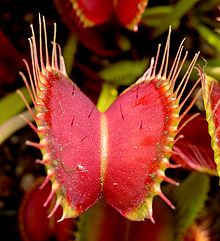A number of students in Ho Chi Minh City, particularly those majoring in biology, have chosen to grow carnivorous plants both out of passion and for research purposes in recent years.
Nurturing a deep love of vegetation, these students have managed to build their own gardens to cultivate the bizarre-looking carnivorous plants.
Setting aside a piece of property for such gardens is not easy at all in this southern hub famous for its expensive land and overcrowded areas.
Carnivorous plants derive some or most of their nutrients (but not energy) from trapping and consuming animals or protozoa, typically insects and other arthropods.
‘Trapped’ by carnivorous plants
Chau Kien Dat took up his gardening hobby when he was a 19-year-old biotechnology student at the HCMC University of Food Industry.
A city-dweller, Dat sometimes felt embarrassed about his limited knowledge of vegetation compared to his university classmates, who hail from the countryside or mountainous regions.
With limited space, Dat started up with conventional ornamental flowering plants such as orchids or cacti.
He was soon introduced to some members of the carnivorous plants.
The plants which come in a wide variety of species, colors and shapes opened a new world and cast an instant spell on the young man.
The world is also less familiar to most Vietnamese people, even biology students.
With hardly any knowledge of the plants and their growing techniques at that time, Dat made a bold decision that he would grow several of them, both to quench his thirst for understanding the lesser-known plants and to share his insight with other like-minded plant lovers.
Starting with a mere handful of such plants, Dat, a university graduate now, has built his own garden which boasts some 200 carnivorous plants.
Chieu Hao Cam, a major in plant physiology at the HCMC University of Science, has also been head over heels in love with the plants.
Enlightening experiences
Carnivorous plants have adapted to thrive in less nutritious land, such as acidic bogs and rock outcroppings.
According to the students who are growing these plants, contrary to common knowledge, it is not easy to grow saplings of carnivorous plants.
It takes some four or five months to successfully grow a sapling which has two or three leaves, and even a year to grow a four-leaf young tree.
Carnivorous plants are generally categorized into six principal genera, namely “Monkey Cups” (Nepenthaceae-Nepenthes), “Venus Flytrap” (Droseraceae-Dionaea-Dionaea muscipula), “Pitfall Trap” (Sarraceniaceae), “Sundew” (Droseraceae-Drosera), Lentibulariaceae-Pinguicula, and Lentibulariaceae-Genlisea/Utricularia.
The Common Swamp Pitcher-Plant (or Nepenthes mirabilis), a subcategory of “Monkey Cups” (Nepenthaceae – Nepenthes), scatters mostly in Vietnam’s central region and has big leaves and long thin pitchers with blue lids.
Vo Tan Dat, a student at the HCMC University of Science, who also owns a garden of carnivorous plants, said that he once thought the plants are intrinsically built to trap and consume insects.
After some time taking care of the plants, Tan Dat and other students learn to their surprise that this is not the case.
Chau Kien Dat, the biotechnology graduate, realized that the plants also survive on water, fertilizer and nutrients obtained from soil.
He also noticed the striking differences between what is taught in biology textbooks and reality.
The textbooks generally maintain that as soon as the prey makes contact with the plants’ leaves, the plants will use its thorns and tentacles to put on their lids and capture the prey inside.
Meanwhile, Kien Dat observed that carnivorous plants typically secrete two or three drops of nectar each time which make insects ‘drunk’ and fall into the pitcher, leaving them unable to climb or fly up.
It takes one to two weeks for the plants to digest an aunt and a fly, not a few hours as the textbooks claim.
The plants do not lure insects or reach out their pitchers to trap them. They can only catch one or two insects a day due to the limited nectar.
To learn more about the planting techniques first-hand, Kien Dat has roamed mountainous regions across the country such as Binh Dinh Province, Binh Thuan Province, and Ba Ria – Vung Tau Province.
He also traveled to several countries, including Thailand and Indonesia, to gather more expertise.
He also founded www.caybatmoi.vn, a website dedicated to his favorite carnivorous plants, to share his knowledge and passion with like-minded friends.
Like us on Facebook or follow us on Twitter to get the latest news about Vietnam!



















































